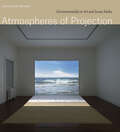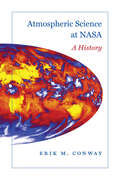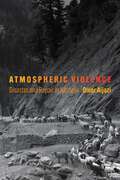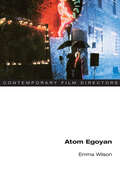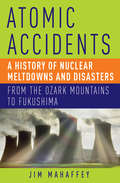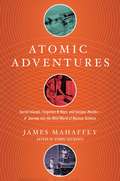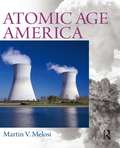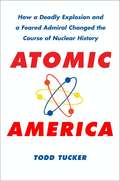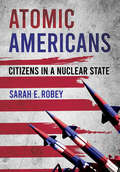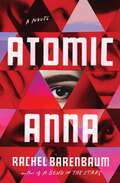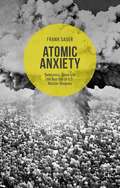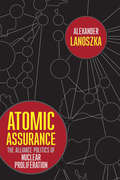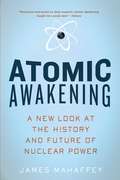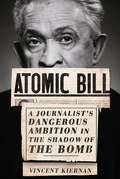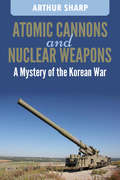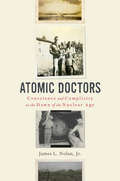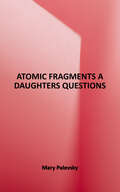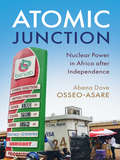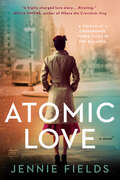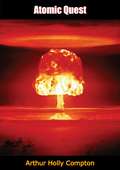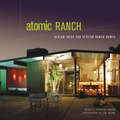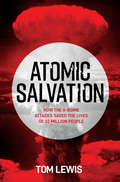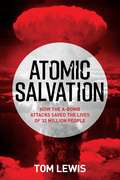- Table View
- List View
Atmospheres of Projection: Environmentality in Art and Screen Media
by Giuliana BrunoBringing together cultural history, visual studies, and media archaeology, Bruno considers the interrelations of projection, atmosphere, and environment. Projection has long been transforming space, from shadow plays to camera obscuras and magic lantern shows. Our fascination with projection is alive on the walls of museums and galleries and woven into our daily lives. Giuliana Bruno explores the histories of projection and atmosphere in visual culture and their continued importance to contemporary artists who are reinventing the projective imagination with atmospheric thinking and the use of elemental media. To explain our fascination with projection and atmosphere, Bruno traverses psychoanalysis, environmental philosophy, architecture, the history of science, visual art, and moving image culture to see how projective mechanisms and their environments have developed over time. She reveals how atmosphere is formed and mediated, how it can change, and what projection can do to modify a site. In so doing, she gives new life to the alchemic possibilities of transformative projective atmospheres. Showing how their “environmentality” produces sites of exchange and relationality, this book binds art to the ecology of atmosphere.
Atmospheres of Projection: Environmentality in Art and Screen Media
by Giuliana BrunoBringing together cultural history, visual studies, and media archaeology, Bruno considers the interrelations of projection, atmosphere, and environment. Projection has long been transforming space, from shadow plays to camera obscuras and magic lantern shows. Our fascination with projection is alive on the walls of museums and galleries and woven into our daily lives. Giuliana Bruno explores the histories of projection and atmosphere in visual culture and their continued importance to contemporary artists who are reinventing the projective imagination with atmospheric thinking and the use of elemental media. To explain our fascination with projection and atmosphere, Bruno traverses psychoanalysis, environmental philosophy, architecture, the history of science, visual art, and moving image culture to see how projective mechanisms and their environments have developed over time. She reveals how atmosphere is formed and mediated, how it can change, and what projection can do to modify a site. In so doing, she gives new life to the alchemic possibilities of transformative projective atmospheres. Showing how their “environmentality” produces sites of exchange and relationality, this book binds art to the ecology of atmosphere.
Atmospheric Science at NASA: A History (New Series in NASA History)
by Erik M. ConwayHonorable Mention, 2008 ASLI Choice Awards. Atmospheric Science Librarians InternationalThis book offers an informed and revealing account of NASA’s involvement in the scientific understanding of the Earth’s atmosphere. Since the nineteenth century, scientists have attempted to understand the complex processes of the Earth’s atmosphere and the weather created within it. This effort has evolved with the development of new technologies—from the first instrument-equipped weather balloons to multibillion-dollar meteorological satellite and planetary science programs. Erik M. Conway chronicles the history of atmospheric science at NASA, tracing the story from its beginnings in 1958, the International Geophysical Year, through to the present, focusing on NASA’s programs and research in meteorology, stratospheric ozone depletion, and planetary climates and global warming. But the story is not only a scientific one. NASA’s researchers operated within an often politically contentious environment. Although environmental issues garnered strong public and political support in the 1970s, the following decades saw increased opposition to environmentalism as a threat to free market capitalism. Atmospheric Science at NASA critically examines this politically controversial science, dissecting the often convoluted roles, motives, and relationships of the various institutional actors involved—among them NASA, congressional appropriation committees, government weather and climate bureaus, and the military.
Atmospheric Violence: Disaster and Repair in Kashmir (Contemporary Ethnography)
by Omer AijaziAtmospheric Violence grapples with the afterlife of environmental disasters and armed conflict and examines how people attempt to flourish despite and alongside continuing violence. Departing from conventional approaches to the study of disaster and conflict that have dominated academic studies of Kashmir, Omer Aijazi’s ethnography of life in the borderlands instead explores possibilities for imagining life otherwise, in an environment where violence is everywhere, or atmospheric.Drawing on extensive fieldwork in the portion of Kashmir under Pakistan’s control and its surrounding mountainscapes, the book takes us to two remote mountainous valleys that have been shaped by recurring environmental disasters, as well as by the landscape of no-go zones, army barracks, and security checkpoints of the contested India/Pakistan border. Through a series of interconnected scenes from the lives of five protagonists, all of whom are precariously situated within their families or societies and rarely enjoy the expected protections of state or community, Aijazi reveals the movements, flows, and intimacies sustained by a landscape that enables alternative modes of life. Blurring the distinctions between story, theory, and activism, he explores what emerges when theory becomes a project of seeing and feeling from the non-normative standpoint of those who, like the book’s protagonists, do not subscribe to the rules by which most others have come to know the world.Bringing the critical study of disaster into conversation with a radical humanist anthropology and the capaciousness of affect theory, held accountable to Black studies and Indigenous studies, Aijazi offers a decolonial approach to disaster studies centering not on trauma and rupture but rather on repair—the social labor through which communities living with disaster refuse the conditions of death imposed upon them and create viable lives for themselves, even amidst constant diminishment and world-annihilation.
Atom Egoyan (Contemporary Film Directors)
by Emma WilsonThe films of Atom Egoyan immerse the viewer in a world of lush sensuality, melancholia, and brooding obsession. From his earliest films Next of Kin and Family Viewing, to his coruscating Exotica and recent projects such as Where the Truth Lies, Egoyan has paid infinite attention to narrative intricacy and psychological complexity. Traumatic loss and its management through ritual return as themes in his films as he explores personal scenarios of mourning and broader issues of genocide, exile, and postmemory, in particular in relation to his own Armenian heritage. In this study, Emma Wilson closely analyzes the range of Egoyan's films and their visual textures, emotional control, and perverse beauty. Offering a full-scale chronological overview of Egoyan's work on films up to and including Where the Truth Lies, Wilson shows the persistence and development of certain structures and themes in Egoyan's cinema: questions of exile and nostalgia, trauma and healing, the family and sexuality. While drawing on ideas about intercultural cinema, Wilson also sets Egoyan's films in the context of contemporary Canadian cinema and European art-house cinema. Egoyan's own comments on his films thread throughout Wilson's analyses, and the book features a recent interview with the director.
Atom Egoyan's 'The Adjuster'
by Tom McsorleyOne of Canada's pre-eminent auteur filmmakers, Atom Egoyan has been celebrated internationally, earning multiple awards from the prestigious Cannes and Toronto Film Festivals and an Academy Award nomination. One of his most accomplished and controversial early works, The Adjuster, is a dark drama about the complex and intense relationship between an insurance adjuster and his clients.In this accessible analysis, Tom McSorley traces the genesis, production, and reception of Egoyan's fourth feature film, from its Cannes Film Festival premiere to its North American commercial release. The book locates The Adjuster in the larger context of Canadian cinema history's peculiar and often troubled evolution, and offers a provocative interpretation of the film's unique analysis of the malaise of materialism in North American culture. Richly illustrated and featuring new interview material with Egoyan himself, this study in the Canadian Cinema series offers an insightful review of one of Atom Egoyan's most searching, unsettling films.
Atomic Accidents: A History of Nuclear Meltdowns and Disasters: From the Ozark Mountains to Fukushima
by James MahaffeyFrom the moment radiation was discovered in the late nineteenth century, nuclear science has had a rich history of innovative scientific exploration and discovery, coupled with mistakes, accidents, and downright disasters. Mahaffey, a long-time advocate of continued nuclear research and nuclear energy, looks at each incident in turn and analyzes what happened and why, often discovering where scientists went wrong when analyzing past meltdowns. Every incident has lead to new facets in understanding about the mighty atom--and Mahaffey puts forth what the future should be for this final frontier of science that still holds so much promise.
Atomic Adventures: Secret Islands, Forgotten N-rays, And Isotopic Murder; A Journey Into The Wild World Of Nuclear Science
by James MahaffeyThe latest investigation from acclaimed nuclear engineer and author James Mahaffey unearths forgotten nuclear endeavors throughout history that were sometimes hair-brained, often risky, and always fascinating. Whether you are a scientist or a poet, pro-nuclear energy or staunch opponent, conspiracy theorist or pragmatist, James Mahaffey's books have served to open up the world of nuclear science like never before. With clear explanations of some of the most complex scientific endeavors in history, Mahaffey's new book looks back at the atom's wild, secretive past and then toward its potentially bright future. Mahaffey unearths lost reactors on far flung Pacific islands and trees that were exposed to active fission that changed gender or bloomed in the dead of winter. He explains why we have nuclear submarines but not nuclear aircraft and why cold fusion doesn't exist. And who knew that radiation counting was once a fashionable trend? Though parts of the nuclear history might seem like a fiction mash-up, where cowboys somehow got a hold of a reactor, Mahaffey's vivid prose holds the reader in thrall of the infectious energy of scientific curiosity and ingenuity that may one day hold the key to solving our energy crisis or sending us to Mars.
Atomic Age America
by Martin V. MelosiAtomic Age America looks at the broad influence of atomic energy¿focusing particularly on nuclear weapons and nuclear power¿on the lives of Americans within a world context. The text examines the social, political, diplomatic, environmental, and technical impacts of atomic energy on the 20th and 21st centuries, with a look back to the origins of atomic theory.
Atomic America
by Todd TuckerOn January 3, 1961, nuclear reactor SL-1 exploded in rural Idaho, spreading radioactive contamination over thousands of acres and killing three men: John Byrnes, Richard McKinley, and Richard Legg. The Army blamed "human error" and a sordid love triangle. Though it has been overshadowed by the accident at Three Mile Island, SL-1 is the only fatal nuclear reactor incident in American history, and it holds serious lessons for a nation poised to embrace nuclear energy once again.Historian Todd Tucker, who first heard the rumors about the Idaho Falls explosion as a trainee in the Navy's nuclear program, suspected there was more to the accident than the rumors suggested. Poring over hundreds of pages of primary sources and interviewing the surviving players led him to a tale of shocking negligence and subterfuge.
Atomic Americans: Citizens in a Nuclear State
by Sarah E. RobeyAt the dawn of the Atomic Age, Americans encountered troubling new questions brought about by the nuclear revolution: In a representative democracy, who is responsible for national public safety? How do citizens imagine themselves as members of the national collective when faced with the priority of individual survival? What do nuclear weapons mean for transparency and accountability in government? What role should scientific experts occupy within a democratic government? Nuclear weapons created a new arena for debating individual and collective rights. In turn, they threatened to destabilize the very basis of American citizenship.As Sarah E. Robey shows in Atomic Americans, people negotiated the contours of nuclear citizenship through overlapping public discussions about survival. Policymakers and citizens disagreed about the scale of civil defense programs and other public safety measures. As the public learned more about the dangers of nuclear fallout, critics articulated concerns about whether the federal government was operating in its citizens' best interests. By the early 1960s, a significant antinuclear movement had emerged, which ultimately contributed to the 1963 nuclear testing ban. Atomic Americans tells the story of a thoughtful body politic engaged in rewriting the rubric of rights and responsibilities that made up American citizenship in the Atomic Age.
Atomic Anna
by Rachel BarenbaumNamed a Most Anticipated Book by Bookish Named a Best Book of the Month by Buzzfeed"The novel is masterfully plotted.&”—New York Times Book Review &“Atomic Anna is a dazzling work of ingenuity and imagination.&”―Téa Obreht,National Book Award finalist and New York Times bestselling author of InlandFrom the author of A Bend in the Stars, an epic adventure as three generations of women work together and travel through time to prevent the Chernobyl disaster and right the wrongs of their past. Three brilliant women. Two life-changing mistakes. One chance to reset the future. In 1986, nuclear scientist Anna Berkova is asleep in her bed in the Soviet Union when Chernobyl's reactor melts down. The energy surge accidentally sends her through time. When she wakes up, she's in 1992 and discovers Molly, her estranged daughter, shot in the chest. Should Anna travel in time to save her daughter or stop Chernobyl? Anna goes to '60s Philadelphia, where Molly is coming of age as an adopted refusenik in a family full of secrets. Molly finds solace in comic books, drawing her own series, Atomic Anna. But when she meets volatile Viktor, their romance sets her life on a dangerous course. Anna then seeks out Molly's daughter, Raisa, in the '80s. Raisa is a lonely teen and math prodigy, who finds new issues of Atomic Anna in unexpected places. Each comic challenges her to solve equations leading to two impossible conclusions: Time travel is real and so is the strange old woman claiming to be her grandmother. These three remarkable women must work together across time to prevent the greatest nuclear disaster of the twentieth century, but simply because you can change the past, does it mean you should?
Atomic Anxiety: Deterrence, Taboo And The Non-use Of U. S. Nuclear Weapons
by Frank SauerWith the concept of 'Atomic Anxiety', this book offers a novel perspective on one of the most important and longstanding puzzles of international politics: the non-use of U.S. nuclear weapons. By focusing on the fear surrounding nuclear weapons, it explains why nuclear deterrence and the nuclear taboo are working at cross purposes in practice.
Atomic Assurance: The Alliance Politics of Nuclear Proliferation (Cornell Studies in Security Affairs)
by Alexander LanoszkaDo alliances curb efforts by states to develop nuclear weapons? Atomic Assurance looks at what makes alliances sufficiently credible to prevent nuclear proliferation; how alliances can break down and so encourage nuclear proliferation; and whether security guarantors like the United States can use alliance ties to end the nuclear efforts of their allies.Alexander Lanoszka finds that military alliances are less useful in preventing allies from acquiring nuclear weapons than conventional wisdom suggests. Through intensive case studies of West Germany, Japan, and South Korea, as well as a series of smaller cases on Great Britain, France, Norway, Australia, and Taiwan, Atomic Assurance shows that it is easier to prevent an ally from initiating a nuclear program than to stop an ally that has already started one; in-theater conventional forces are crucial in making American nuclear guarantees credible; the American coercion of allies who started, or were tempted to start, a nuclear weapons program has played less of a role in forestalling nuclear proliferation than analysts have assumed; and the economic or technological reliance of a security-dependent ally on the United States works better to reverse or to halt that ally’s nuclear bid than anything else.Crossing diplomatic history, international relations, foreign policy, grand strategy, and nuclear strategy, Lanoszka’s book reworks our understanding of the power and importance of alliances in stopping nuclear proliferation.
Atomic Awakening: A New Look at the History and Future of Nuclear Power
by James Mahaffey“Persuasive and based on deep research. Atomic Awakening taught me a great deal."—Nature The American public's introduction to nuclear technology was manifested in destruction and death. With Hiroshima and the Cold War still ringing in our ears, our perception of all things nuclear is seen through the lens of weapons development. Nuclear power is full of mind-bending theories, deep secrets, and the misdirection of public consciousness, some deliberate, some accidental. The result of this fixation on bombs and fallout is that the development of a non-polluting, renewable energy source stands frozen in time. Outlining nuclear energy's discovery and applications throughout history, Mahaffey's brilliant and accessible book is essential to understanding the astounding phenomenon of nuclear power in an age where renewable energy and climate change have become the defining concerns of the twenty-first century.
Atomic Bill: A Journalist's Dangerous Ambition in the Shadow of the Bomb
by Vincent KiernanIn Atomic Bill, Vincent Kiernan examines the fraught career of New York Times science journalist, William L. Laurence and shows his professional and personal lives to be a cautionary tale of dangerous proximity to power. Laurence was fascinated with atomic science and its militarization. When the Manhattan Project drew near to perfecting the atomic bomb, he was recruited to write much of the government's press materials that were distributed on the day that Hiroshima was obliterated. That instantly crowned Laurence as one of the leading journalistic experts on the atomic bomb. As the Cold War dawned, some assessed Laurence as a propagandist defending the militarization of atomic energy. For others, he was a skilled science communicator who provided the public with a deep understanding of the atomic bomb. Laurence leveraged his perch at the Times to engage in paid speechmaking, book writing, filmmaking, and radio broadcasting. His work for the Times declined in quality even as his relationships with people in power grew closer and more lucrative. Atomic Bill reveals extraordinary ethical lapses by Laurence such as a cheating scandal at Harvard University and plagiarizing from press releases about atomic bomb tests in the Pacific. In 1963 a conflict of interest related to the 1964 World's Fair in New York City led to his forced retirement from the Times. Kiernan shows Laurence to have set the trend, common among today's journalists of science and technology, to prioritize gee-whiz coverage of discoveries. That approach, in which Laurence served the interests of governmental official and scientists, recommends a full revision of our understanding of the dawn of the atomic era.
Atomic Cannons and Nuclear Weapons: A mystery of the Korean War
by Arthur G. SharpAn examination of the preparedness U.S. forces took to use nuclear warfare weaponry in the Korean War and an exmination of the usage of atomic cannons.
Atomic Doctors: Conscience And Complicity At The Dawn Of The Nuclear Age
by James L. NolanAn unflinching examination of the moral and professional dilemmas faced by physicians who took part in the Manhattan Project.After his father died, James L. Nolan, Jr., took possession of a box of private family materials. To his surprise, the small secret archive contained a treasure trove of information about his grandfather’s role as a doctor in the Manhattan Project. Dr. Nolan, it turned out, had been a significant figure. A talented ob-gyn radiologist, he cared for the scientists on the project, organized safety and evacuation plans for the Trinity test at Alamogordo, escorted the “Little Boy” bomb from Los Alamos to the Pacific Islands, and was one of the first Americans to enter the irradiated ruins of Hiroshima and Nagasaki.Participation on the project challenged Dr. Nolan’s instincts as a healer. He and his medical colleagues were often conflicted, torn between their duty and desire to win the war and their oaths to protect life. Atomic Doctors follows these physicians as they sought to maximize the health and safety of those exposed to nuclear radiation, all the while serving leaders determined to minimize delays and maintain secrecy. Called upon both to guard against the harmful effects of radiation and to downplay its hazards, doctors struggled with the ethics of ending the deadliest of all wars using the most lethal of all weapons. Their work became a very human drama of ideals, co-optation, and complicity.A vital and vivid account of a largely unknown chapter in atomic history, Atomic Doctors is a profound meditation on the moral dilemmas that ordinary people face in extraordinary times.
Atomic Fragments: A Daughter's Questions
by Mary PalevskyMore than most of us, Mary Palevsky needed to come to terms with the moral complexities of the atomic bomb: Her parents worked on its development during World War II and were profoundly changed by that experience. After they died, unanswered questions sent their daughter on a search for understanding. <p><p>This compelling, sometimes heart-wrenching chronicle is the story of that quest. It takes her, and us, on a journey into the minds, memories, and emotions of the bomb builders. Scientists Hans Bethe, Edward Teller, Joseph Rotblat, Herbert York, Philip Morrison, Robert Wilson, and philosopher David Hawkins responded to Palevsky's personal approach in a way that dramatically expanded their previously published statements. Her skill and passion as an interlocutor prompt these men to recall their lives vividly and to reexamine their own decisions, debating within themselves the complex issues raised by the bomb. The author herself, seeking to comprehend the widely differing ways in which individual scientists made choices about the bomb and made sense of their work, deeply reconsiders those questions of commitment and conscience her parents faced. <p><p>In personal vignettes that complement the interviews, she captures other remembrances of the bomb through commemorative events and chance encounters with people who were "there." Her concluding chapter reframes the crucial moral questions in terms that show the questions themselves to be the abiding legacy we all share. This beautifully written book bridges generations to make its readers participants in the ongoing dialogue about science and philosophy, war and peace.
Atomic Junction: Nuclear Power in Africa after Independence
by Abena Dove Osseo-AsareAfter Atomic Junction, along the Haatso-Atomic Road there lies the Ghana Atomic Energy Commission, home to Africa's first nuclear programme after independence. Travelling along this road, Abena Dove Osseo-Asare gathers together stories of conflict and compromise on an African nuclear frontier. She speaks with a generation of African scientists who became captivated with 'the atom' and studied in the Soviet Union to make nuclear physics their own. On Pluton Lane and Gamma Avenue, these scientists displaced quiet farming villages in their bid to establish a scientific metropolis, creating an epicentre for Ghana's nuclear physics community. By placing interviews with town leaders, physicists and local entrepreneurs alongside archival records, Osseo-Asare explores the impact of scientific pursuit on areas surrounding the reactor, focusing on how residents came to interpret activities on these 'Atomic Lands'. This combination of historical research, personal and ethnographic observations shows how Ghanaians now stand at a crossroad, where some push to install more reactors, whilst others merely seek pipe-born water.
Atomic Love
by Jennie Fields"A novel of science, love, espionage, beautiful writing, and a heroine who carves a strong path in the world of men. As far as I'm concerned there is nothing left to want."--Ann Patchett, author The Dutch House"A highly-charged love story that reveals the dangerous energy at the heart of every real connection...Riveting."--Delia Owens, author of Where the Crawdads SingLove. Desire. Betrayal. Her choice could save a nation.Chicago, 1950. Rosalind Porter has always defied expectations--in her work as a physicist on the Manhattan Project and in her passionate love affair with colleague Thomas Weaver. Five years after the end of both, her guilt over the bomb and her heartbreak over Weaver are intertwined. She desperately misses her work in the lab, yet has almost resigned herself to a more conventional life.Then Weaver gets back in touch--and so does the FBI. Special Agent Charlie Szydlo wants Roz to spy on Weaver, whom the FBI suspects of passing nuclear secrets to Russia. Roz helped to develop these secrets and knows better than anyone the devastating power such knowledge holds. But can she spy on a man she still loves, despite her better instincts? At the same time, something about Charlie draws her in. He's a former prisoner of war haunted by his past, just as her past haunts her. As Rosalind's feelings for each man deepen, so too does the danger she finds herself in. She will have to choose: the man who taught her how to love . . . or the man her love might save?
Atomic Quest
by Arthur Holly ComptonDr. Compton’s book gives the reader an inside view of history in the making of the weapon that changed the world – the atomic bomb. As director of the Metallurgical Laboratory of the Manhattan Project he was a major participant in the research, production and testing of the bomb.From the vantage point of the key position he held from 1941 until 1945, Dr. Compton tells the whole story of the bomb’s progress from the presentation of the project to President Roosevelt, through its planning, research, and building phases, to its use in Japan. He depicts the project as a tremendous group effort enlisting the knowledge and talents of countless scientists, industrialists, and administrators, all of whom were working for the greater good of a nation in need of their help.“an absorbing and eminently readable account…It is packed with new information and enlivened with precious detail and illuminating insights into the minds and personalities of the chief actors in the drama.”—Henry Guerlac, The New York Times Book Review“Dr. Compton is a thinking man whose reflections range far beyond the confines of his scientific work: indeed, the distinctive quality of his book lies in his ability to reconcile the atomic bomb and similar operations with his belief as a practicing Christian.”—John Barkham, Saturday Review Syndicate“It should be required reading for every American, for the free world…The narrative alone makes the book worth reading; its hopeful philosophy makes it mandatory reading.”—Robert S. Kleckner, Chicago Sunday Tribune“For those who were in the project, it will mean many recollections. For those who were not, it should give an inkling of the character and capacity of many of the individuals, including Arthur Compton, who made success possible.”—Lieutenant General Leslie R. Groves, U.S. Army (Retired)
Atomic Ranch: Design Ideas for Stylish Ranch Homes
by Michelle Gringeri-BrownAn in-depth exploration of midcentury residential architecture in America, with extensive photos and design tips included.Post-World War II ranches (1946–1970) range from the decidedly modern gable-roofed Joseph Eichler tracts in the San Francisco Bay area and butterfly wing houses in Palm Springs, Florida, to the unassuming brick or stucco L-shaped ranches and split-levels so common throughout the United States. In this book Michelle Gringeri-Brown and Jim Brown, founders and publishers of the popular quarterly Atomic Ranch magazine, extol the virtues of the tract, split-level, rambler home and its many unique qualities: private front facades, open floor plans, secluded bedroom wings, walls of glass, and an easy-living style. From updated homes with high-end Italian kitchens, terrazzo floors, and modern furniture to affordable homeowner renovations with eclectic thrift-store furnishings, Atomic Ranch presents twenty-five homes showcasing inspiring examples of stylish living through beautiful color photographs, including before and after shots, design-tip sidebars, and a thorough resource index. Atomic Ranch reveals:Hallmarks of the ranch styleInspiring original ranch homesRanch house transformations and makeoversPreservation of mid-century neighborhoodsAdding personality to a ranch homeYards and landscapingA helpful resource section and index
Atomic Salvation: How the A-Bomb Saved the Lives of 32 Million People
by Tom LewisA thought-provoking analysis of the bombing of Hiroshima and Nagasaki—and what might have happened if conventional weapons were used instead.It has always been a difficult concept to stomach—that the atomic bombs dropped on Hiroshima and Nagasaki in 1945, causing such horrific suffering and destruction, also brought about peace. Attitudes toward the event have changed through the years, from grateful relief that World War II was ended to widespread condemnation of the United States.Atomic Salvation investigates the full situation—examining documents from both Japanese and Allied sources, but also using in-depth analysis to extend beyond the mere recounting of statistics. It charts the full extent of the possible casualties on both sides had a conventional assault akin to D-Day gone ahead against Japan. The work is not concerned solely with the military necessity to use the bombs; it also investigates why that necessity has been increasingly challenged over the successive decades.Controversially, the book demonstrates that Japan would have suffered far greater casualties—likely around 28 million—if the nation had been attacked in the manner by which Germany was defeated: by amphibious assault, artillery and air attacks preceding infantry insertion, and finally by subduing the last of the defenders of the enemy capital. It also investigates the enormous political pressure placed on America as a result of their military situation. The Truman administration had little choice but to use the new weapon given the more than a million deaths that Allied forces would undoubtedly have suffered through conventional assault.By chartingreaction to the bombings over time, Atomic Salvation shows that there has been relentless pressure on the world to condemn what at the time was seen as the best, and only, military solution to end the conflict. Never has such an exhaustive analysis been made of the necessity behind bringing World War II to a halt.
Atomic Salvation: How the A-Bomb attacks saved the lives of 32 million people
by Doctor Tom LewisSo did not the atomic weapons bring about a great peace? Since the initial grateful acknowledgement of the success of the A-bomb attacks in ending World War II, there has been a steady reversal of opinion and sentiment: from a first hearty appreciation to a condemnation by many, of the United States for its actions.Atomic Salvation investigates the full situation of the times to a previously unplumbed depth. It examines documents from both Japanese and Allied sources, but it uses logical in-depth analysis to extend beyond the mere recounting of statistics. It charts the full extent of the possible casualties on both sides if a conventional assault akin to D-Day had gone ahead. The work is concerned solely with the military necessity to use the bombs, but it also investigates why that necessity has been increasingly challenged over the successive decades. Controversially, the book shows that the Japanese nation would have lost many millions of their people – likely around 28 million – if the nation had been attacked in the manner by which Germany was defeated: by amphibious assault; artillery and air attacks preceding infantry insertion, and finally by subduing the last of the defenders of the enemy capital. From the other side, the book investigates the enormous political pressure placed on America as a result of their military situation. The USA&’s Truman Administration had little choice but to use the new weapon given the more than a million deaths Allied forces would undoubtedly have suffered through conventional assault. Through investigation of reactions then and since, Atomic Salvation charts reaction to the bombings. It looks briefly at a range of reactions through the decades and shows that there has been relentless pressure on the world to condemn what at the time was seen as the best, and the only, military solution to end the war. Never has such an exhaustive analysis been made of the necessity behind bringing World War II to a halt.
